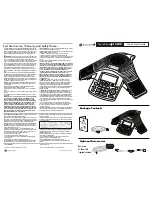
Feature Overview
Cisco Desktop Collaboration Experience DX600 provide an integrated suite of collaborative applications,
including Cisco WebEx, Cisco Unified Presence, instant messaging, email, visual voicemail, and Cisco Unified
Communications Manager voice and video telephony features. Cisco DX600 series phones also support
applications from Google Play
™
. For an overview of the features that Cisco DX600 series phones support and
for tips on configuring them, see
Features, Templates, Services, and User Setup, on page 113
.
As with other network devices, you must configure Cisco DX600 series phones to prepare them to access
Cisco Unified Communications Manager and the rest of the IP network. By using DHCP, you have fewer
settings to configure on a device. If your network requires it, however, you can manually configure information
such as an IP address, TFTP server, and subnet information.
Cisco DX600 series phones can interact with other services and devices on your IP network to provide enhanced
functionality. For example, you can integrate Cisco Unified Communications Manager with the corporate
Lightweight Directory Access Protocol 3 (LDAP3) standard directory to enable users to search for coworker
contact information directly from their IP phones.
Finally, because the Cisco DX600 series phone is a network device, you can obtain detailed status information
from it directly. This information can assist you with troubleshooting any problems users might encounter
when using their Cisco DX600 series phones.
Telephony Feature Administration
You can modify additional settings for the Cisco DX600 series phone from Cisco Unified Communications
Manager Administration. Use this web-based application to set up phone registration criteria and calling search
spaces, and to configure corporate directories and services, among other tasks. See the related topics and the
Cisco Unified Communications Manager documentation for additional information.
For more information about Cisco Unified Communications Manager Administration, see
Cisco Unified Communications Manager documentation, including
Cisco Unified Communications Manager
Administration Guide
. You can also use the context-sensitive help available within the application for guidance.
You can access Cisco Unified Communications Manager documentation at this location:
http://www.cisco.com/en/US/products/sw/voicesw/ps556/tsd_products_support_series_home.html
You can access Cisco Business Edition 5000 documentation at this location:
http://www.cisco.com/en/US/products/ps7273/tsd_products_support_series_home.html
Network Parameters
You can configure parameters such as DHCP, TFTP, and IP settings on the phone itself. You can also obtain
statistics about a current call or firmware versions on the phone.
Information for End Users
If you are a system administrator, you are likely the primary source of information for Cisco DX600 series
phone users in your network or company. To ensure that you distribute the most current feature and procedural
information, familiarize yourself with Cisco Desktop Collaboration Experience DX600 Series documentation.
Make sure to visit the Cisco Desktop Collaboration Experience DX600 Series website:
http://www.cisco.com/en/US/products/ps12956/tsd_products_support_series_home.html
Cisco Desktop Collaboration Experience DX650 Administration Guide, Release 10.1(1)
17
Supported Features
















































